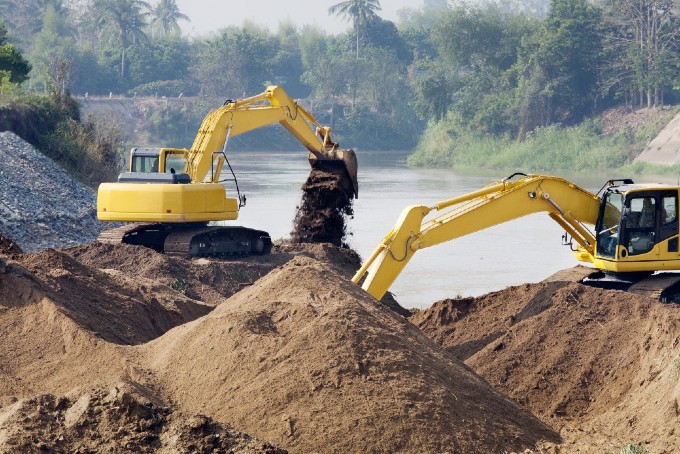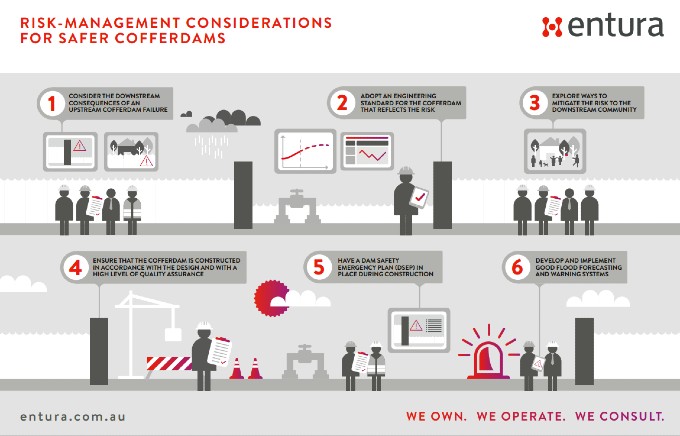THOUGHT LEADERSHIP
What levels of flood protection and downstream risk are acceptable for cofferdams?
In previous thought leadership articles, we’ve argued that the downstream consequence of dam failure is a better measure of dam risk than the size of the dam. For example, saddle dams can often have significant consequences downstream, despite being smaller than the main dam. The same applies to cofferdams.
A cofferdam is a temporary dam that diverts a river during construction of the permanent dam. The cofferdam enables the main dam site to be dewatered and protected throughout construction. The river flows are diverted around the site through a diversion channel, conduit or tunnel, which has a certain flood capacity beyond which the cofferdam would overtop. Overtopping of the cofferdam could lead to failure of this temporary dam, and the ramifications of such an event depend on the volume of stored water behind the cofferdam and the consequences downstream.
There is greater scope to accept more risk in the design and construction of the cofferdam if the construction period is short, the cofferdam is relatively small and the downstream consequences are minimal. But if the cofferdam is a high structure with significant consequences downstream, what level of flood protection is acceptable?
This issue is common when constructing a dam on a large river. Despite the cofferdam usually being significantly smaller than the main dam, and although the risk exposure period is only the duration of the construction of the permanent dam, we must consider the life safety risk to the downstream community. If the downstream consequence is great, appropriate dam engineering principles and standards need to be applied to the design and construction of these temporary cofferdams to protect the downstream community from unacceptable risk during the construction of the main dam.
There is no consistent, appropriate international practice or standard for risks associated with handling flood during construction, be it for river diversion during construction of a new dam, or flood management during remedial works for an existing dam. The overall perception of dam engineers has been that higher risk levels are acceptable during short-term construction periods, compared with the long-term risks for the completed structure.
Traditionally, the flood capacity associated with the cofferdam and diversion works was based around the construction flood risk and became a cost optimisation problem, taking into account the lost time and damages that would be caused by overtopping. However, if there is a population downstream, we are talking about the downstream risk to life, which is no longer simply a financial issue.
The outdated Australian National Committee on Large Dams (ANCOLD) Guidelines on Design Floods for Dams 1986 proposed that the river diversion flood risk during the relatively short construction period of a cofferdam should be an equivalent order of safety to the recommended design flood relevant to the consequence over the life of the permanent dam. For a high-consequence-category dam with a construction period of 5 years, the guidelines recommended a 1-in-500-year river diversion flood capacity.
This is similar to the Brazilian guidelines given in the International Committee on Large Dams (ICOLD) Bulletin 170 – Flood Evaluation and Dam Safety (2018), where for each management stage of the river during construction, the flood capacity for the diversion works should be defined based on the risk of flooding downstream, taking into account the exposure time. The following table is based on the Brazilian guidelines, taking into account the risk to human lives downstream. If there is real danger of loss of human lives and there would be major damage to the works and their progress, then the annual risk of damage to the cofferdam should be less than 1%.
| Category | Annual risk of damage |
| No danger to human lives No provision for serious damage occurring to the work or its progress |
5% to 20% |
| No danger to human lives Some provision for significant damage to the work or its progress |
2% to 5% |
| Some danger to human lives Provision for significant damage to the work and its progress |
1% to 2% |
|
Real danger of loss of human lives Provision for major damage to the work and its progress |
<1% |
According to the ‘Diversion of Large Brazilian Rivers’ document prepared by the Brazilian Committee on Dams for the 2009 ICOLD Congress in Brasilia, the maximum river diversion flood capacity provided for major dam projects in Brazil was the 1-in-500-year flood. This is currently considered to be the internationally accepted standard for temporary cofferdams, but is it acceptable from the perspective of risk to life for downstream populations?
Owners need to consider the degree to which the risks imposed on the population by the dam during construction are acceptable and defensible. The current ANCOLD Guidelines on Selection of Acceptable Flood Capacity for Dams (2000) indicates that there is no consensus or risk standard that specifically considers whether risk-to-life criteria that relate to the overall risk over the long life of a dam are equally applicable to the short-term construction period. Compliance with various risk-to-life criteria would generally result in very conservative construction flood provisions compared with historical practice, and therefore should only be used to assist when considering and deciding on construction flood options. Although it may have been traditional to accept higher risks during construction than those acceptable for the completed dam in service, it is unlikely that such practice would be defensible in the event of a failure resulting in loss of life.
When deciding on the diversion flood capacity for the cofferdam arrangement, consider these elements:
- Consider the downstream consequences of an upstream cofferdam failure. This is particularly important if there is a downstream population that would be at risk. To quantify the impact of dam failure, dambreak assessment may be needed for the upstream cofferdam.
- Adopt an engineering standard for the cofferdam that reflects the risk. The higher the consequences downstream, the more stringent the design standards should be for the cofferdam, including the flood capacity of the diversion works. The design should consider the potential failure modes of the cofferdam (e.g. flood overtopping, internal erosion, etc.), and appropriate design measures should be adopted so that the chance of failure is appropriately low.
- Explore ways to mitigate the risk to the downstream community by:
- giving preference to lower cofferdam options with larger diversion flood capacity
- staging the flood protection works to minimise exposure time
- including emergency spillways or fuse plugs as part of the cofferdam design to control any downstream flooding
- preparing for major flooding events (as discussed below).
- Ensure that the cofferdam is constructed in accordance with the design and with a high level of quality assurance, especially if the cofferdam is demonstrated to be a high-consequence-category dam. The quality control (QC) and quality assurance (QA) processes on site must reflect the downstream consequences and risk to life. The higher the risk, the higher the justification for investing in appropriate QA/QC for the cofferdam construction.
- Have a dam safety emergency plan (DSEP) in place during construction. If downstream populations are at risk, it would be appropriate to have a DSEP for the cofferdam during construction of the permanent dam, along with appropriate monitoring of the cofferdam. Having a DSEP in place during construction is good practice for any high-consequence dam. By monitoring the dam, it is possible to identify early whether a dam safety emergency is developing. Early identification allows appropriate action to be taken as soon as possible, through intervention or early warning. This will help to mitigate the residual risk for the downstream population, and enable the contractor to intervene at the construction site. It will also provide clear lines of communication and understanding of responsibilities, should any potential dam safety emergency occur.
- Develop and implement good flood forecasting and warning systems. If a contractor has enough warning before the flood occurs, they can act to mitigate potential impacts. For example, construction workers and equipment can be removed from the area between the upstream and downstream cofferdams. Adequate warning time will dramatically increase the chance of survival should the dam fail. With appropriate rainfall stations and streamflow stations, flood prediction and flood warning models can be developed to provide increased foresight before a large flood event, so that there is more time to take pre-emptive action and inform any downstream communities.
No matter the size or the impermanence of a dam structure, always consider the downstream consequences. Even though a cofferdam is a temporary structure, it is still a dam, and its failure could lead to significant downstream consequences including risks to life. And that’s why we should consider applying the same dam safety practices to cofferdams as we do for permanent dams. In the end, it’s all about identifying and managing the risks and protecting what’s vulnerable downstream.
Find out what prompted Richard to write this piece below.
Entura has been involved in the decision-making process for many cofferdams associated with the construction of large dams on large rivers. If you’d like to discuss how we can assist you with planning, designing and constructing safer dams, please contact Richard Herweynen, Paul Southcott or Phillip Ellerton.
About the author
Richard Herweynen is Entura’s Technical Director, Water. Richard has three decades of experience in dam and hydropower engineering, and has worked throughout the Indo-Pacific region on both dam and hydropower projects, covering all aspects including investigations, feasibility studies, detailed design, construction liaison, operation and maintenance and risk assessment for both new and existing projects. Richard has been part of a number of recent expert review panels for major water projects. He participated in the ANCOLD working group for concrete gravity dams and is the Chairman of the ICOLD technical committee on engineering activities in the planning process for water resources projects. Richard has won many engineering excellence and innovation awards (including Engineers Australia’s Professional Engineer of the Year 2012 – Tasmanian Division), and has published more than 30 technical papers on dam engineering.
MORE THOUGHT LEADERSHIP ARTICLES
23 September, 2021








